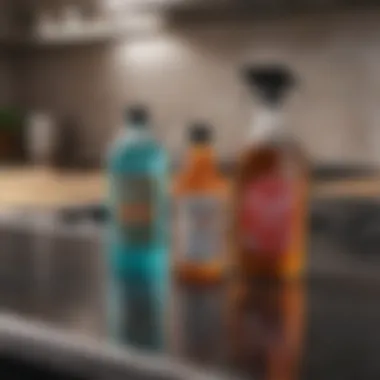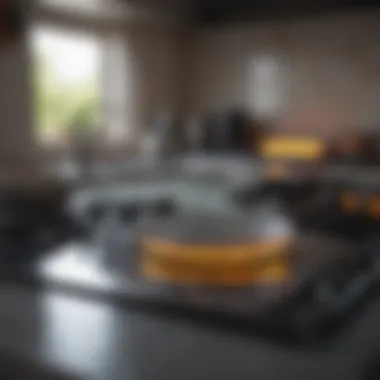Expert Techniques for Cleaning Glass Cooktops


Intro
Cleaning glass cooktops is essential for keeping your kitchen looking modern and appealing. They are an integral part of many kitchens due to their elegance and functionality. However, these surfaces can become stained or dirty, impacting their visual appeal and usability. Knowing how to clean and maintain these cooktops is crucial.
This guide explores effective cleaning methods tailored specifically for glass cooktop surfaces. We will discuss the right tools and products, the various types of stains and their removal techniques, and provide general hints for long-term maintenance. By following these steps, homeowners can enjoy a glass cooktop that remains in pristine condition, uplifting the overall aesthetic of their kitchen.
"The beauty of a glass cooktop lies not just in its appearance but in its performance. Proper care ensures both are maintained."
Understanding the specifics of cleaning glass cooktops can make a substantial difference in your cooking experience. Let's begin by identifying the necessary features and products for an optimal clean.
Understanding Glass Cooktops
Understanding glass cooktops is crucial for maintaining a kitchen's aesthetic and functionality. These surfaces, while visually appealing, require specific care to prevent damage and sustain their performance. This section delves into what glass cooktops are, their benefits, and the challenges they present, helping homeowners to appreciate their investment in this modern kitchen element.
What is a Glass Cooktop?
A glass cooktop is a flat cooking surface made from ceramic glass. These cooktops operate with electric coils or induction heating, offering a sleek, minimalist look that complements various kitchen designs. Unlike traditional metal burners, glass cooktops feature a smooth surface that enhances the visual appeal of the kitchen while providing efficient cooking capabilities.
Their temperature control mechanisms can vary depending on the type, with induction cooktops being particularly notable for their quick heat-up times and energy efficiency. However, understanding the specific characteristics of your model is essential for proper maintenance.
Benefits of Glass Cooktops
Glass cooktops present several advantages:
- Aesthetic Appeal: Their sleek design elevates the overall look of the kitchen.
- Ease of Cleaning: Smooth surfaces allow for quick wipe-downs after spills, reducing cleaning time.
- Heat Distribution: Many models offer even heat distribution, ensuring food cooks more uniformly.
- Variety of Styles: They come in different designs and colors to match any kitchen decor.
This combination of aesthetics and functionality makes glass cooktops a popular choice among homeowners.
Common Challenges with Glass Cooktops
Despite their advantages, glass cooktops have some challenges. These include:
- Scratches: The surface can be scratched by abrasive cleaners or pots and pans with rough bottoms.
- Stains: Burnt-on food can leave stubborn stains that require specific cleaning methods to remove effectively.
- Cracks: Extreme temperature changes can sometimes lead to cracks, impacting their usability.
- Heat Sensitivity: Some models may have limitations in how much heat they can withstand, necessitating caution during cooking.
Understanding these challenges is important as it informs cleaning techniques and maintenance strategies, ensuring the longevity of the cooktop.
Essential Tools and Products
In the realm of glass cooktop maintenance, the importance of appropriate tools and products cannot be stressed enough. Using the right items not only enhances cleaning efficiency but also plays a critical role in preserving the integrity and look of the cooktop surface. Failure to utilize suitable cleaning instruments can lead to scratches, streaks, or other damage that compromises the cooktop's appearance and functionality. Thus, equipping oneself with the right tools and solutions is essential for ensuring a clean and maintained cooking environment.
Cleaning Tools Overview
The first step to effectively clean a glass cooktop is understanding the essential cleaning tools required for the task. Microfiber cloths are arguably paramount in this context; they are gentle on surfaces and proficient at trapping dirt and residues without scratching the glass.


In addition to microfiber cloths, a non-abrasive scrub pad is vital for dealing with any stuck-on food particles or stains without causing harm. It is important to select a pad explicitly labeled for use on glass surfaces, as some pads can be too abrasive and lead to scratches. A scraper or razor blade designed for cooktop surfaces can also be beneficial for gently removing burnt-on residues, but caution is necessary to avoid damaging the glass.
Lastly, a squeegee can assist in removing excess cleaning solution and ensuring a streak-free finish, making it a valuable addition to your cleaning toolkit.
Recommended Cleaning Solutions
While tools are critical, the type of cleaning solution used also plays a significant role in achieving optimal results. Many homeowners find success using commercially available cooktop cleaners, which are specifically formulated to tackle the unique challenges of glass surfaces. Brands like Weiman, Cerama Bryte, and Bar Keepers Friend offer effective solutions that are safe for glass.
For those who prefer a more natural approach, a mixture of vinegar and water can serve as an excellent homemade cleaner. This solution tackles grime effectively while avoiding harsh chemicals that may harm the environment or the cooktop itself. Adding a drop of dish soap can enhance its efficacy—however, it is wise to test any solution on a small, inconspicuous spot first to ensure compatibility with your cooktop.
Accessibility of Cleaning Products
Accessibility is another crucial factor to consider when discussing cleaning products for glass cooktops. Many recommended cleaning products are widely available at local grocery stores, hardware stores, and online. This means that homeowners can easily restock their cleaning supplies without much hassle.
It is wise to take note of the ingredients in cleaning products. While many commercial options are effective, some may contain harsh chemicals that could harm the cooktop over time. Natural alternatives, while potentially less aggressive, can also be quite effective and are often safer for the environment.
In summary, the journey to maintaining a pristine glass cooktop begins with selecting the right tools and products. By understanding what to use and ensuring easy access to these items, homeowners position themselves for success in their cleaning endeavors.
Step-by-Step Cleaning Process
Cleaning a glass cooktop efficiently requires a clear approach. Each step of the cleaning process serves a specific purpose in ensuring the cooktop regains its shine and functionality. By following a structured process, you maximize the effectiveness of the cleaning, allowing for easier maintenance and preventing damage to the surface. This section outlines the steps to achieve optimal results with minimal effort.
Pre-Cleaning Preparation
Before beginning the cleaning process, it is vital to prepare the area and gather needed materials. Start by ensuring the cooktop is completely cool to avoid burns or further damage to the surface. Remove any cookware, utensils, or leftover food debris, as these can interfere with the cleaning process. You may also want to put on rubber gloves to protect your hands from cleaning solutions. Moreover, having nearby towels ready helps in drying and further cleaning where necessary. The preparation stage sets a solid foundation for a successful clean.
Initial Wipe-down
The initial wipe-down is crucial for removing loose dirt and crumbs. Use a damp cloth or paper towel to gently wipe the surface. This step helps in lifting away small particles that can scratch the glass during the subsequent cleaning stages. Avoid using abrasive materials during this stage. Following this, ensure that the cloth is clean and that no trace of food residue remains. A clean starting point dramatically enhances the effectiveness of later cleaning actions.
Application of Cleaning Solution
Once the initial wipe-down is complete, it’s time to apply the chosen cleaning solution. There are many products specifically designed for glass cooktops, which can be quite effective. Spray a generous amount directly onto the surface. Allow it to sit for a few moments to break down any stubborn stains or residues. Ensure that the solution covers the entire cooktop evenly. This application not only aids in stain removal but also contributes to glass cooktop maintenance, protecting the surface from future build-up.
Scrubbing Techniques
After the cleaning solution has set, use a non-abrasive scrub pad or a soft cloth to scrub the surface gently. Focus on areas with built-up residue or stains. Unlike standard scrubbing, which may cause scratches, using a gentle approach is essential. Circular motions may be more effective, as they help lift away residue without damaging the glass. Patience is needed here. For persistent spots, more than one round of scrubbing may be necessary.
Final Rinse and Dry
After scrubbing, the final rinse is necessary to ensure no cleaning solution or debris is left on the surface. Use a clean damp cloth to wipe down the cooktop thoroughly, removing all cleaning solution remnants. Following the rinse, dry the surface with a microfiber towel to avoid water spots. This step emphasizes a streak-free finish and completes the cleaning process effectively. By taking this final step, you ensure that the glass cooktop is not only clean but looks impeccable.
"Proper care and cleaning techniques can prolong the life of your glass cooktop, maintaining its aesthetic appeal."
Dealing with Stains and Residues


Dealing with stains and residues on glass cooktops is crucial for maintaining their aesthetic and functional integrity. When splatters or spills occur during cooking, they can lead to unsightly marks that detract from the overall appearance of the kitchen. Moreover, leaving these residues can cause further damage if not addressed timely. This section explores common stains, processes for removing them, and tips on preventing scratches and scuffs, ensuring your cooktop remains in optimal condition.
Common Stains and Their Causes
Understanding common stains is the first step towards effective cleaning. There are several types of stains that may appear on glass cooktops:
- Food Splatter: These are often the result of cooking methods that involve high heat, causing oils and other substances to splatter. Common culprits include sautéing and frying.
- Burnt Sugar: When sugars are overheated, they can create sticky residues that are tough to clean. It's common when cooking desserts or candies.
- Water Marks: Hard water can leave mineral deposits that look like streaks.
- Grease Stains: These arise from cooking fatty foods, leading to a film that can be difficult to remove.
Recognizing the source of these stains helps in selecting the appropriate cleaning methods.
Removing Burnt-On Residue
Burnt-on residue poses a significant challenge for glass cooktop owners. To effectively remove these stubborn marks:
- Soaking the Area: Apply a few drops of dish soap mixed with warm water onto the burnt area. Allow it to sit for about 10-15 minutes to loosen the residue.
- Gentle Scrubbing: Use a non-abrasive scrub pad specifically designed for glass surfaces. Scrub gently in a circular motion. Avoid steel wool or any abrasive materials as they may scratch the surface.
- Spatula Use: For severely burnt areas, using a plastic spatula can help lift off the residue without damaging the glass.
- Final Rinse: Wipe down with a damp microfiber cloth to remove soap residue and ensure the cooktop is clean.
Addressing Scratches and Scuffs
While glass cooktops are designed to resist scratches, they are not indestructible. Here are some methods to address minor scratches and scuffs:
- Baking Soda Paste: Mix baking soda with a small amount of water to create a paste. Apply it to the scratched area and let it sit for 15-20 minutes before wiping off with a damp cloth.
- Ceramic Cooktop Cleaner: Some brands offer specialized cleaners that can help reduce the appearance of scratches. Apply according to the manufacturer’s instructions.
It is essential to manage scratches early, as deep ones can compromise the cooktop's functionality and lead to costly repairs.
Maintaining glass cooktops involves understanding both the stains and the appropriate methods for their removal. By addressing stains and residues promptly, homeowners can preserve the beauty and efficiency of their kitchen appliances.
Preventive Maintenance
Preventive maintenance plays a crucial role in ensuring the longevity and aesthetic appeal of glass cooktops. Regular upkeep can help homeowners avoid taxing cleaning processes and extensive repairs later on. With minimal effort, a well-maintained cooktop can maintain its shine and functionality, making it a pleasure to use and showcase.
Daily Cleaning Practices
Implementing daily cleaning practices is vital for sustaining cleanliness. After each use, it is wise to perform a quick wipe-down. Using a soft cloth or sponge dampened with water, gently remove any spills or food particles. This is especially important for sugary or acidic substances that can leave lingering stains.
Additionally, applying a modest amount of dedicated cooktop cleaner can enhance appearance. Always follow the manufacturer’s recommendations regarding compatible products to avoid chemical reactions. Doing so not only preserves surface quality but also minimizes wear over time.
Weekly Deep Clean Recommendations
A weekly deep clean should be scheduled to tackle the build-up that daily cleaning may miss. Start by removing all cookware and allowing the cooktop to cool completely. A thorough scrub with a non-abrasive scrub pad and glass cooktop cleaner can help remove any persistent residues.
Key Tip: Avoid metal scrapers as they can create scratches. Instead, utilize tools specifically designed for glass cooktops.
It is also recommended to inspect the cooktop for any signs of damage or wear. Addressing these problems quickly can prevent further issues.


Long-Term Care Tips
For optimal long-term care, consider investing in protective coatings that can enhance the glass's resistance to stains and scratches. These products create a barrier against common cooking mishaps, allowing for easier maintenance overall.
Maintain awareness of how cookware interacts with the cooktop. Avoid heavy items or pots with rough bottoms, as this can contribute to scratching and chipping over time. Additionally, training users, especially in shared households, can help deter potential damage caused by negligence.
Best Practices and Safety Considerations
Cleaning glass cooktops necessitates following best practices and safety considerations to achieve optimal results while preventing damage. Understanding the significance of correct cleaning methods not only enhances the longevity of the cooktop's surface but also ensures safe cooking experiences. Whether you are a novice home cook or a culinary expert, it is crucial to instill these habits for maintaining a pristine kitchen environment.
Safety Guidelines for Cleaning
When engaging in cleaning tasks, safety must not be overlooked. Here are several guidelines designed to protect users and their cooktops:
- Unplug the appliance before starting the cleaning process. This ensures that the cooktop cannot accidentally turn on during cleaning.
- Allow the cooktop to cool completely after use. Cleaning a hot surface can lead to burns or damage to both the cooktop and cleaning tools.
- Use gloves to protect your hands from chemical exposure, especially if using commercial cleaning solutions.
In addition to these precautions, be aware of any allergies to specific cleaning agents and confirm the product suitability for glass surfaces.
Avoiding Damage to Glass Cooktops
The surface of glass cooktops is delicate and can be easily scratched or damaged if not treated correctly. Adhering to certain practices can significantly minimize the risk of harm:
- Always opt for non-abrasive cleaners and sponges. Avoid steel wool, scouring pads, or hard-bristled brushes.
- When cleaning, avoid excessive pressure. Light scrubbing is sufficient in most cases.
- If food spills are burnt on, instead of scraping hard, use a razor blade at a low angle to gently lift the residue without scratching the surface.
- Prevent water or cleaning solution from pooling on the cooktop, as this can lead to residues or even streaks if not wiped up promptly.
"Using the right tools and techniques reduces the possibility of permanent damage to glass cooktops, keeping their aesthetic appeal intact."
When to Seek Professional Help
In specific situations, cleaning may pose risks that surpass DIY capabilities. Knowing when to seek professional assistance can save time and potential damage:
- If the cooktop has deep scratches or seems to have damage that is beyond simple cleaning techniques.
- When stains appear stubborn and resistant to all cleaning methods. Professionals have access to more advanced treatments that can effectively address those issues.
- If there's a concern about electrical safety due to heat exposure or malfunction.
Occasionally, seeking an expert not only removes the burden of worry but ensures that the cooktop is adequately cared for, maintaining its functionality and visual appeal.
By incorporating these best practices along with necessary safety measures, your glass cooktop can remain both clean and functional. Investing time in proper maintenance can elevate the cooking experience and maintain the cooktop's pristine condition.
End
Cleaning glass cooktops is not just a task; it is an essential aspect of kitchen maintenance that ensures both functionality and aesthetics. The final section of this guide will summarize the critical points discussed and reflect on the ongoing commitment to keeping glass cooktops in optimal condition. A clean cooktop enhances the overall look of a kitchen, creating an inviting atmosphere. It also promotes efficiency in cooking. Stains and residues on the surface can not only detract from beauty but can also impact the cooking process. Thus, regular maintenance is crucial.
Summary of Key Points
This article spans various important topics related to glass cooktop maintenance. Key points include:
- Understanding Your Cooktop: Knowledge about the materials and buildup patterns helps in choosing appropriate cleaning methods.
- Essential Tools: The right tools, such as non-abrasive pads and suitable cleaning solutions, are pivotal for effective cleaning.
- Step-by-Step Process: Following a detailed cleaning protocol ensures thorough maintenance that prevents scratches and stubborn stains.
- Dealing with Stains: Awareness of common cooking stains and proper removal methods prevents long-term damage.
- Preventive Practices: Regular cleaning and maintenance help in minimizing effort required over time.
- Safety First: Always adhering to safety practices protects both the user and the appliance.
Final Thoughts on Cooktop Maintenance
"A clean kitchen is not just about hygiene; it is about making a statement."
By applying the insights from this guide, anyone can maintain their glass cooktops, enhancing their kitchen environment.







